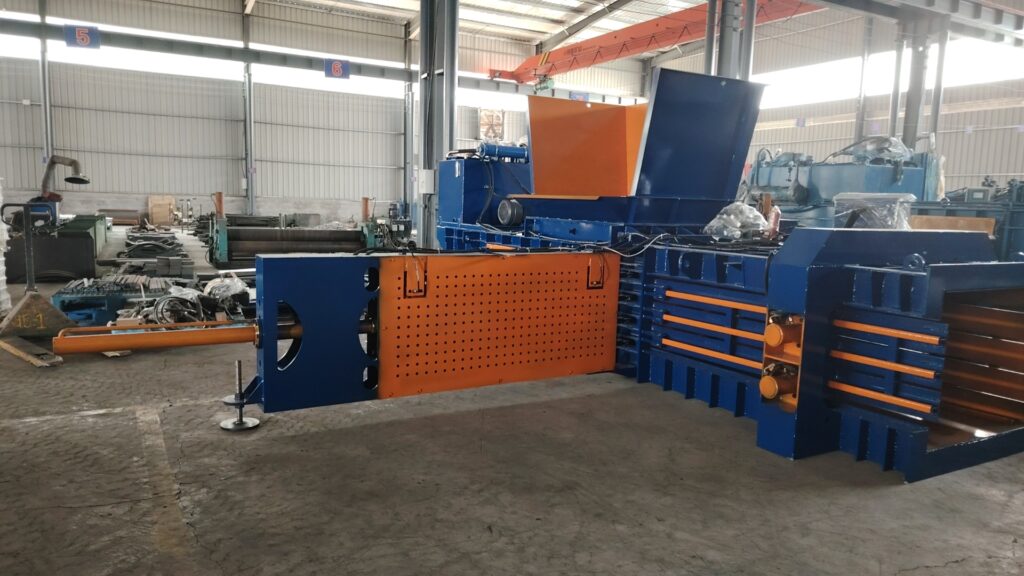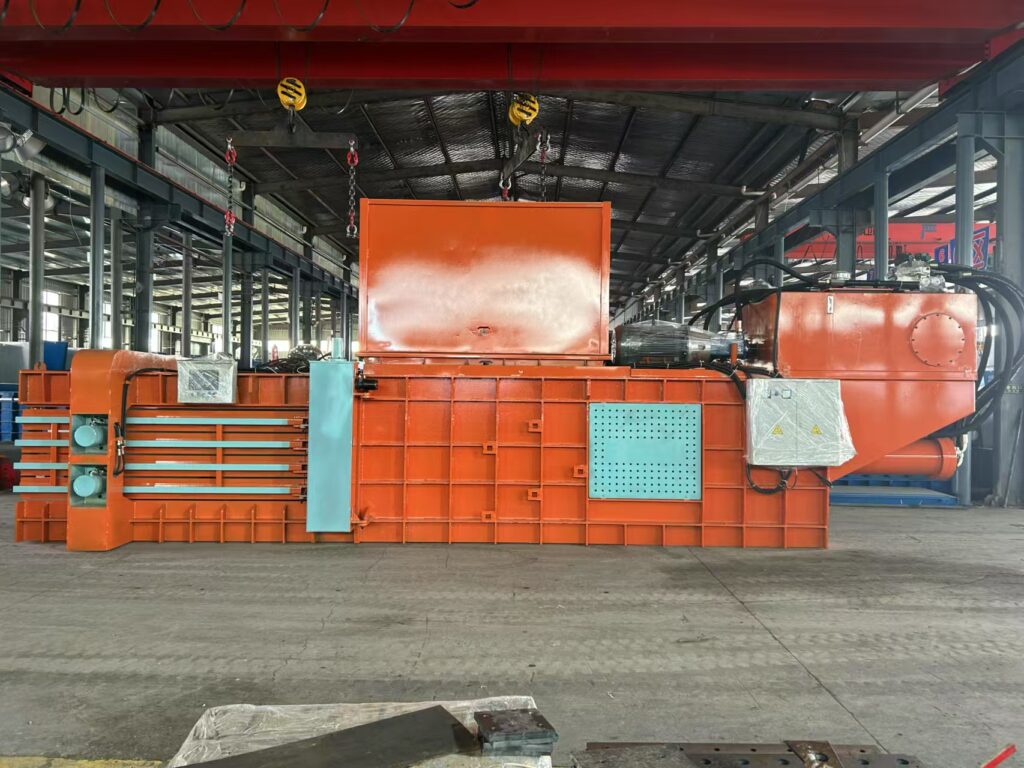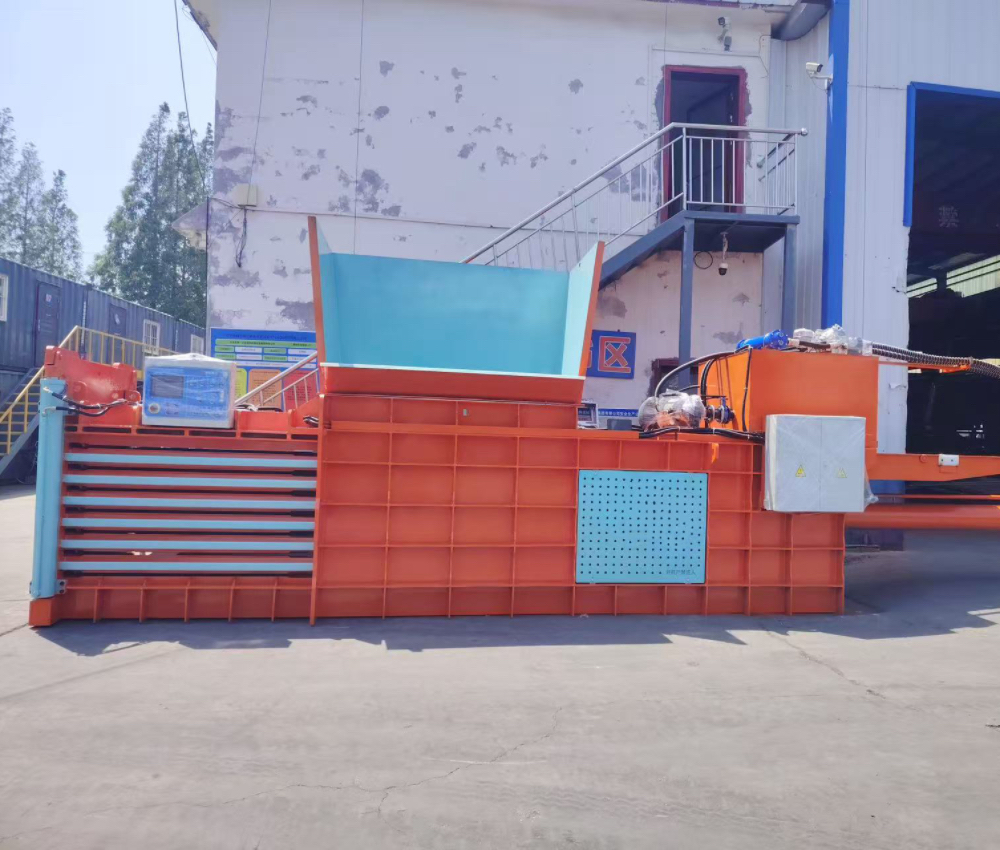What Is A Horizontal Baler Machine?

A Horizontal Baler Machine is a specialized industrial equipment designed to compress recyclable materials, such as paper, cardboard, plastics, and textiles, into compact, manageable bales. Unlike vertical balers, which push materials downwards, horizontal balers work by feeding materials horizontally into a chamber and applying pressure via hydraulic cylinders. This method allows for continuous feeding, higher efficiency, and larger bale sizes, making them ideal for large-scale recycling operations and manufacturing plants.
Horizontal balers come in manual, semi-automatic, and fully automatic versions, depending on the level of automation required. They are widely used in recycling centers, warehouses, paper mills, and plastic processing factories.
With advanced technology, some horizontal balers also come with integrated shredders, allowing materials like cardboard or plastics to be shredded before compression. This feature ensures denser bales and improves storage and transport efficiency.
Why Choose A Horizontal Baler Machine?

Efficient Material Handling
One of the primary benefits of a horizontal baler is high throughput. These machines can handle large volumes of materials continuously, which reduces storage space requirements and streamlines the recycling process. Unlike vertical balers, horizontal models can process materials without frequent stops, saving valuable operational time.
Cost Reduction
Compressing materials into bales lowers transportation costs. Trucks can carry more weight in a compact form, saving on logistics and fuel expenses. It also reduces labor costs since fewer staff are needed to manage and move materials.
Environmental Benefits
By efficiently compacting recyclables, horizontal balers help reduce landfill waste, minimize carbon emissions during transport, and support sustainable practices for businesses. They also encourage recycling habits within industrial facilities, promoting long-term ecological benefits.
Versatility
Horizontal balers can process a wide range of materials, including waste paper, cardboard, plastics, textiles, and even soft metals. This versatility makes them an excellent investment for multi-material recycling operations. Some machines are designed with adjustable pressure settings, making them suitable for both light and heavy-duty materials.
How To Use A Horizontal Baler Machine

Step 1: Prepare The Materials
Sort your recyclable materials according to type. Remove large, non-compressible items or hazardous materials. Proper preparation ensures efficient compression and longer machine lifespan. Some facilities also pre-shred materials to improve compaction and bale density.
Step 2: Feed Materials Into The Chamber
Depending on the model, you can manually feed materials or use a conveyor system for automatic feeding. Horizontal balers often feature a large feed opening for ease of operation. Ensuring the feed area is organized prevents jams and enhances safety.
Step 3: Start The Compression Cycle
Activate the hydraulic system to compress the materials. The hydraulic cylinders apply consistent pressure to form dense bales. Modern machines allow you to adjust compression force, depending on the material type and desired bale density. Some high-end models have programmable pressure settings for different materials, increasing efficiency and reducing wear.
Step 4: Bind The Bales
Once the material is compressed, secure the bales using steel wires, straps, or baling twine. Fully automatic machines may have integrated binding systems, saving time and labor. Proper binding ensures the bales maintain their shape during storage and transport.
Step 5: Eject The Bales
After binding, the bales are pushed out of the chamber. They are now ready for storage or transportation. Some horizontal balers feature a conveyor or trolley system for easy removal of heavy bales. Always ensure that the ejection area is clear and that safety guards are in place to prevent accidents.
Choosing The Right Horizontal Baler Machine
Consider Your Material Type
Different materials require different compression forces and bale sizes. For example, cardboard may need moderate pressure, while plastics or textiles require stronger hydraulic cylinders. Soft metals and mixed materials often require machines with robust structural frames and advanced hydraulic systems.
Evaluate Production Capacity
Determine your daily or monthly processing volume. High-volume operations may need fully automatic horizontal balers with continuous feeding, while smaller facilities may prefer semi-automatic models. Understanding your production capacity helps prevent overloading the machine and ensures longevity.
Bale Size And Weight
Consider the desired bale dimensions. Typical sizes range from 800×400×700 mm to over 1500×1200×1200 mm, with weights from 50 kg to several tons. Larger bales reduce handling costs but require stronger machinery. Some machines also offer adjustable bale sizes to adapt to transport or storage requirements.
Automation Level
-
Manual: Simple, low-cost, but labor-intensive.
-
Semi-Automatic: Combines manual feeding with automatic compression and binding.
-
Fully Automatic: Fully integrated feeding, compression, and binding for high efficiency.
Automation also affects safety, as automatic feeding and ejection systems reduce the risk of operator injury.
Space And Installation
Horizontal balers require floor space for the machine, feed system, and bale storage area. Ensure your facility can accommodate the equipment and provides adequate power supply. Some models also require reinforced flooring due to the machine’s heavy weight. Proper layout planning improves workflow and efficiency.
Maintenance Tips For Horizontal Baler Machines
-
Regular Lubrication: Keep hydraulic cylinders, chains, and bearings well-lubricated to reduce wear.
-
Check Hydraulic Oil: Maintain oil levels and replace periodically for consistent compression performance.
-
Inspect Blades And Cylinders: Ensure cutting blades (if included) and cylinders are in good condition to prevent damage.
-
Clean Feed Area: Remove debris to prevent jams and maintain efficiency.
-
Regular Safety Checks: Inspect emergency stops, guards, and sensors to ensure safe operation.
Routine maintenance not only extends the machine’s lifespan but also prevents costly downtime.
Practical Applications Of Horizontal Baler Machines
Horizontal balers are not only suitable for recycling centers but also widely used in manufacturing plants, warehouses, paper mills, and plastic processing factories. They are ideal for companies that generate large volumes of recyclable materials daily.
Some industries, such as automotive, packaging, and furniture manufacturing, produce bulky waste like cardboard, plastic wrap, wood panels, or metal scraps. Horizontal balers can compress these materials efficiently, reducing storage space and simplifying logistics.
Additionally, modern horizontal balers can be integrated with conveyors, shredders, and automated binding systems, making them suitable for continuous production lines. This integration minimizes downtime, reduces labor requirements, and ensures consistent bale quality.
Choosing the right baler for your application involves assessing material type, daily volume, bale size, and automation needs. Investing in the proper machine guarantees higher productivity, lower operational costs, and long-term sustainability.
Conclusion
Horizontal baler machines are an essential solution for efficient, cost-effective, and environmentally friendly material recycling. By understanding the types, benefits, usage steps, and selection criteria, businesses can make informed decisions to optimize their recycling process and reduce operational costs.
Whether you are handling cardboard, plastics, textiles, or mixed recyclables, selecting the right horizontal baler ensures your facility operates efficiently and sustainably.
Investing in a high-quality horizontal baler is not just about compressing waste; it’s about improving workflow efficiency, reducing operational costs, and contributing to environmental sustainability. With proper operation and maintenance, a horizontal baler can be a long-term asset for any recycling or manufacturing facility.
